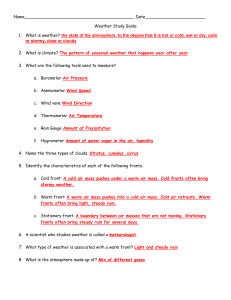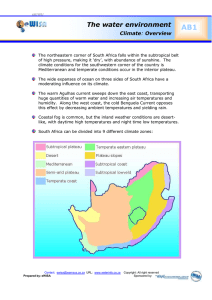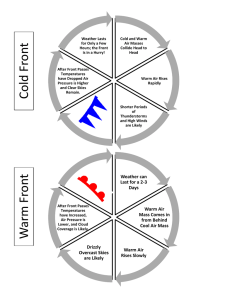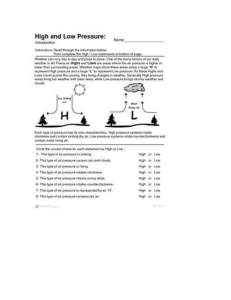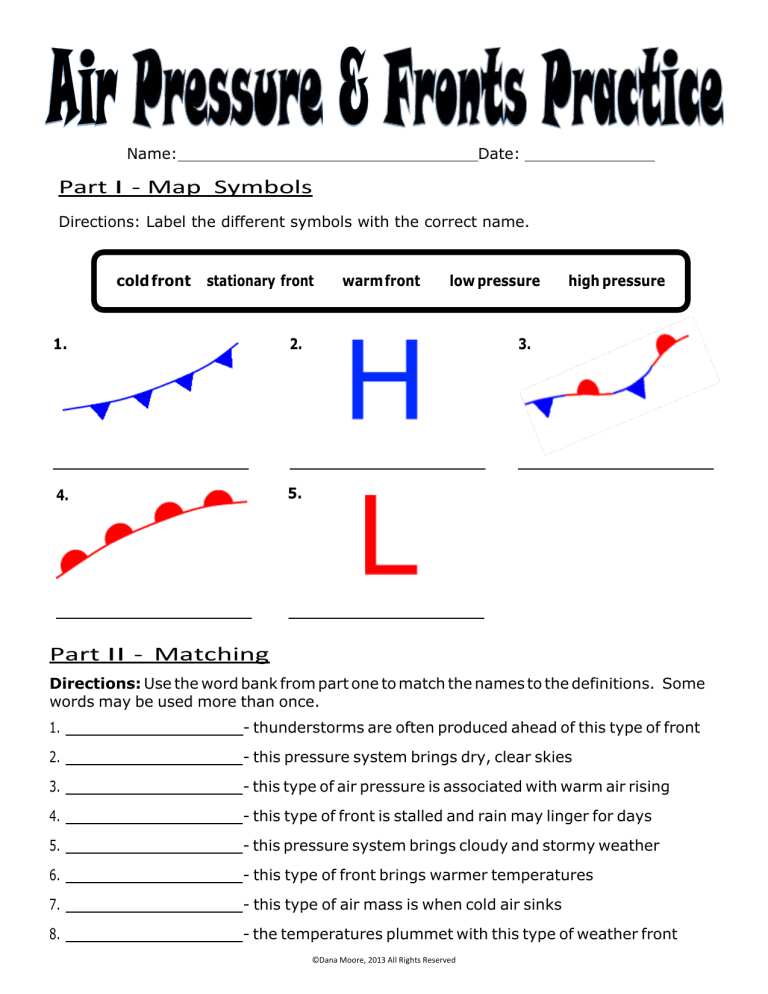
Name: Date: Part I - Map Symbols Directions: Label the different symbols with the correct name. cold front stationary front 1. 2. 4. 5. warm front low pressure high pressure 3. Part II - Matching Directions: Use the word bank from part one to match the names to the definitions. Some words may be used more than once. 1. - thunderstorms are often produced ahead of this type of front 2. - this pressure system brings dry, clear skies 3. - this type of air pressure is associated with warm air rising 4. - this type of front is stalled and rain may linger for days 5. - this pressure system brings cloudy and stormy weather 6. - this type of front brings warmer temperatures 7. - this type of air mass is when cold air sinks 8. - the temperatures plummet with this type of weather front ©Dana Moore, 2013 All Rights Reserved Part III - Reading a Map Directions: Answer the following questions using the map. °47 F °51 F °30 F °67 F °59 F °42 F °68 F °70 F 1. Which cities are experiencing dry, clear conditions? °65 F °72 F 2. What cities are probably experiencing lingering rain showers? 3. What type of front passed through Little Rock? Explain what type of weather they probably had from the front that passed through. 4. Which city will be “cooling off” soon? 5. Which cities are probably experiencing stormy or rainy weather? 6. Which city is cold enough to support frozen precipitation like snow or sleet? ©Dana Moore, 2013 All Rights Reserved Part I - Map Symbols Directions: Label the different symbols with the correct name. cold front stationary front 1. warm front low pressure 2. cold front 4. high pressure 3. high pressure stationary front 5. warm front low pressure Part II - Matching Directions: Use the word bank from part one to match the names to the definitions. Some words may be used more than once. 1. cold front - thunderstorms are often produced ahead of this type of front 2. high pressure - this pressure system brings dry, clear skies 3. low pressure - this type of air pressure is associated with warm air rising 4. stationary front - this type of front is stalled and rain may linger for days 5. low pressure - this pressure system brings cloudy and stormy weather 6. warm front - this type of front brings warmer temperatures 7. high pressure - this type of air mass is when cold air sinks 8. cold front - the temperatures plummet with this type of weather front ©Dana Moore, 2013 All Rights Reserved Part III - Reading a Map Directions: Answer the following questions using the map. °47 F °51 F °30 F °59 F °42 F °67 F °68 F 1. Which cities are experiencing dry, clear conditions? °70 F °65 F °72 F Seattle, Chicago, New York City, and Washington D.C. 2. What cities are probably experiencing lingering rain showers? Orlando and Miami 3. What type of front passed through Little Rock? Explain what type of weather they probably had from the front that passed through. Cold front; Little Rock probably experienced stormy and rainy weather since a cold front just passed through. Their temperatures should be colder too. 4. Which city will be “cooling off” soon? New Orleans 5. Which cities are probably experiencing stormy or rainy weather? Los Angeles, Charleston, 6. Which city is cold enough to support frozen precipitation like snow or sleet? Chicago ©Dana Moore, 2013 All Rights Reserved
